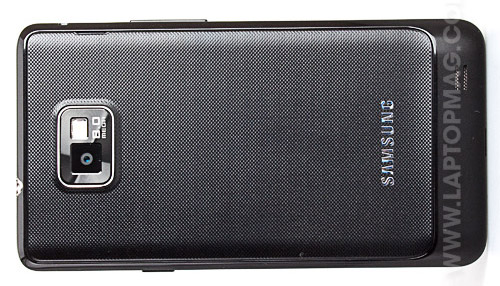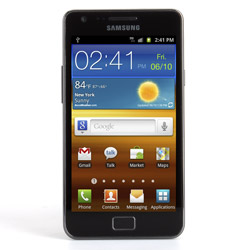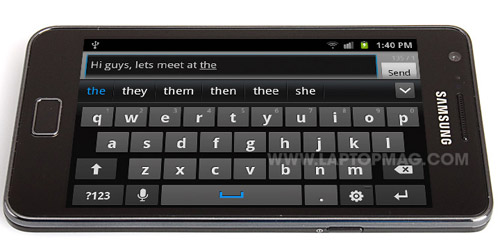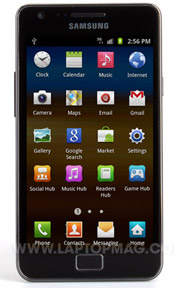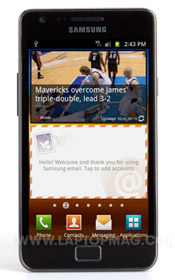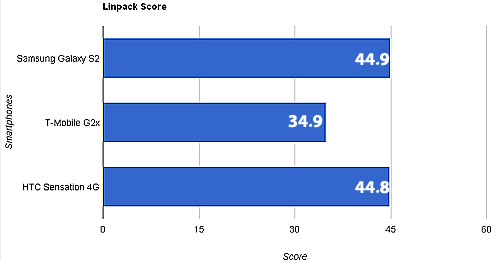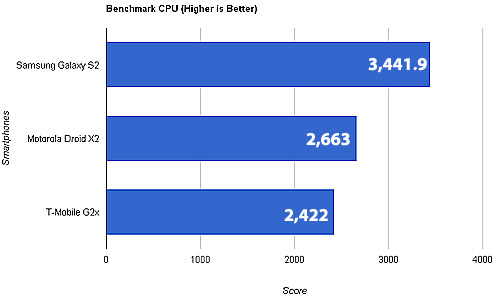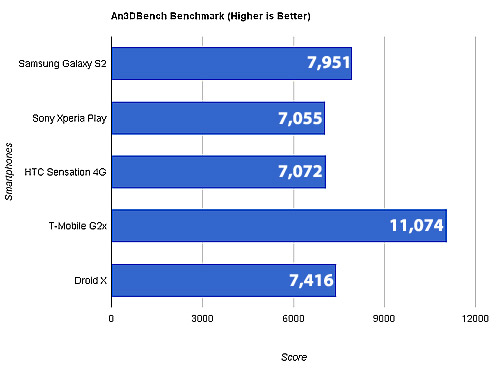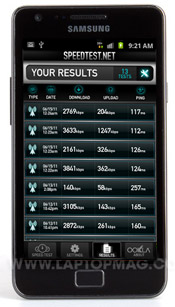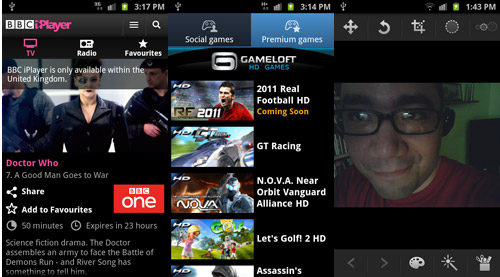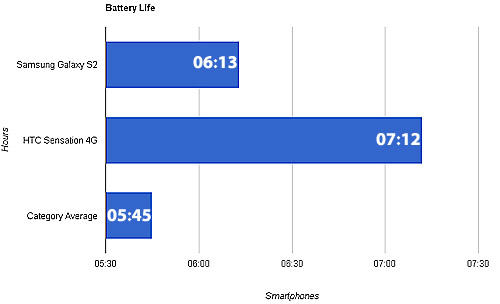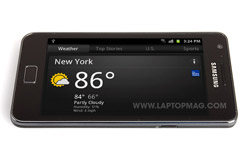Laptop Mag Verdict
The Samsung Galaxy S II is a fast dual-core world phone with a fantastic display, an ultra-slim profile, and well-designed software.
Pros
- +
Very fast performance
- +
Vivid Super AMOLED Plus screen
- +
Extremely thin design
- +
1080p video capture
- +
Loud speaker
- +
Robust software
Cons
- -
Expensive
- -
Slow data speeds in the U.S.
- -
Lacks dedicated search button
Why you can trust Laptop Mag
The superphone arms race keeps escalating, and Samsung has fired the latest salvo with the Galaxy S II, one of the fastest and thinnest Android devices yet. This unlocked phone packs a dual-core processor and an 8-megapixel camera behind a luscious 4.3-inch Super AMOLED Plus screen, yet it manages to be just 0.33 inches thick and weigh a feather-light 4 ounces. Is this beautiful $799 Android world phone (unlocked) worth the sky-high price?
Design
Almost impossibly slim, the flat, rectangular Samsung Galaxy S II is all black and sculpted with seductively smooth curves. It measures a mere 4.9 x 2.6 x 0.33 inches, and at 4 ounces, it barely tips the scales, especially compared to other 4.3-inch phones such as the Motorola Droid X2 (5.47 ounces), the LG Revolution (6.1 ounces), and even the well-crafted HTC Sensation 4G (5.2 ounces).
The Galaxy S II is an exercise in minimalism. The front is dominated by edge-to-edge glass; below is a physical Home button that lacks any markings, and capacitive keys for Menu and Back are on its left and right, respectively. Unfortunately, these buttons aren't always visible, and the S II completely lacks a Search button, which is included on most Android phones. Above the display are a 2-MP front-facing camera, a silver Samsung Logo, and a barely visible earpiece.
Click to enlarge
Along the left side of the Galaxy S II is a long volume bar; the right has a tiny power key within easy thumb reach, the bottom has a microUSB port, and a headphone jack graces the top edge. On the back is an 8-MP camera with flash. The plastic battery cover sports a textured surface that resists fingerprints, but it feels a tad chintzy when removed. Users can access the SIM card without touching the battery, but not the microSD card slot.
Alas, there's no HDMI port for HD video output, but you can purchase an MHL adapter that connects the microUSB cable to an HDMI adapter, which plugs into your TV. Using this adapter, the phone's display immediately appeared on a 55-inch Samsung HDTV once we plugged it in. We were able to browse the phone and view videos and photos as easily as on the phone itself.
Sign up to receive The Snapshot, a free special dispatch from Laptop Mag, in your inbox.
Display, Keyboard, Audio
Click to enlarge
The lack of many front controls removes any distraction from the Galaxy S II's 4.3-inch WVGA Super AMOLED Plus display. Its 800 x 400 WVGA resolution may not be as sharp as the qHD displays (960 x 540) on other phones such as the HTC Sensation 4G, but the Galaxy S II's screen looks great. Blacks were deep and endless, and colors appeared vibrant, lush, and richly saturated. The YouTube HD Trailers for both Super 8 and Captain America: The First Avenger were stunning, with lifelike flesh tones, colorful explosions, and plenty of detail in dark areas. Viewing angles were very wide, too. Our only complaint about this--and every other--Super AMOLED Plus screen is that the whites aren't that bright, which is noticeable when using the browser.
For punching out messages, the Galaxy S II comes with a virtual keyboard designed by Samsung. With keys that have a good amount of space between them, predictive text input, and a long space bar in landscape mode, it gets the job done. That said, to add punctuation other than a period, users must switch to the separate symbol keyboard, which is frustrating. We also noticed that the S II didn't automatically enter periods when we pressed the space bar twice after a sentence, a feature that many other Android phones have. Keys in the top letter row, though, can be long-pressed for numbers. There's also a dedicated keyboard setting button to toggle various functions and activate Swype, a text entry method for stringing words together by drawing lines through letters.
Click to enlarge
For such a thin device, the Galaxy S II delivered a surprising amount of volume. When we watched videos, both music and dialogue were pretty loud and even had a nice bit of bass. We could really hear the low-end grooves on our dance track of choice, "Paper Romance" by Groove Armada. We also noticed that placing the phone on a hard flat surface boosted the volume.
Software, Interface, TouchWiz 4.0
Click to enlarge
The Samsung Galaxy S II is a premium handset in terms of software, too. Running Android 2.3.3 Gingerbread, the device uses the most recent iteration of Samsung's custom UI, TouchWiz 4.0. Greeting you first is the lock screen; on the bottom is the time and date, and the top has a notification bar for quick alerts. A quick finger swipe in any direction unlocks the phone.
As expected, users can customize all of the S II's seven home screens with widgets and shortcuts to apps. The main screen is populated by a large combo clock and weather widget, plus one for Google search. Below that are shortcuts to often-used apps (Gmail, Maps, Market, and Talk). At the bottom are software buttons for Applications, Contacts, Messaging, and Phone. Pinching the display pulls up a bird's-eye view of all seven screens at once; changing their order is a simple matter of dragging to a preferred position. Pulling a finger from the top of the screen displays the notification window. Five tiles here let users toggle Wi-Fi, Bluetooth, GPS, Sound, and Auto-rotation functions.
As with previous versions of TouchWiz, pressing a home screen for a few seconds opens an option to add widgets, shortcuts, and change wallpapers. Similar to iOS, users can use this area to create folders for app shortcuts and documents. Those familiar with older versions of TouchWiz will recognize the Widget Drawer, complete with a slider bar offering choices using slick 3D effects. Instead of the vertically scrolling app tray found on most Android phones, Samsung takes a page from the iPhone's book and uses a horizontal application menu.
Click to enlargeTouchWiz 4.0 has two especially cool new features. Live Panel lets you resize widgets; press and hold on a widget, then release, and it's outlined in yellow. A tab at the lower right lets you expand or shrink the widget as you like. As you make the widget larger, more and more information appears. For example, with the Accuweather widget minimized, it displays just the current temperature; expanding it reveals the five-day forecast.
The other new feature in TouchWiz adds a new wrinkle to zooming. Place two fingers on the screen, and tilting the phone back and forth with cause the view to zoom in and out. This function works most smoothly for images and web pages but operates on anything with zoom enabled, such as office documents.
While it doesn't have as tight an integration with Facebook and Twitter as HTC's Sense UI does, TouchWiz lets you link a friend's Facebook and Twitter profile to their contact information, pulling in his or her photo.
Specs and Performance
Running Samsung's 1-GHz dual-core Application Processor and with 16GB of internal memory, the Galaxy S II packs a hefty punch. The phone notched a lofty Linpack score of 44.9, 29 points higher than the average Android device. This soundly beats the dual core-powered T-Mobile G2x (34.9, Nvidia Tegra 2) but is practically equal to the dual-core HTC Sensation 4G (44.8, 1.2-GHz dual-core Snapdragon).
Click to enlarge
On the Benchmark CPU test, the Galaxy S II really flexed its dual-core muscle, scoring a mind-blowing 3,441.9, the highest score we've seen yet. That's more than double the typical smartphone (1,289). The only handset that came close was the Motorola Droid X2 (2,663, Nvidia Tegra 2) with the G2x behind it (2,422).
Click to enlarge
In terms of graphics, the Galaxy S II also came out swinging, achieving an impressive An3DBench score of 7,951, more than 1,700 points above average. This showing is enough to beat back the Xperia Play (7,055), HTC Sensation 4G (7,072), and the Droid X2 (7,416), but not the G2x (11,074) which is still the reigning king on this test.
Click to enlargeIn everyday use, the Galaxy S II also felt snappy and very responsive. Applications opened immediately, and flipping through menus and the app tray was especially quick. Playing a demo version of the futuristic N.O.V.A shooter was super smooth, plus the game looked great on the phone's AMOLED screen, with plenty of color and detail.
Web Surfing
Click to enlarge
The Samsung Galaxy S II is an unlocked GSM world phone designed to operate mainly on European and Asian cellular networks. Still, that doesn't mean users in the States can't play ball. While the handset will only sip data slowly on T-Mobile at EDGE rates, it is compatible with AT&T's HSPA+ network. With an active AT&T SIM inserted, we logged average data download speeds of 3.1 Mbps in Queens, NY, a respectable 3G result. Uploads, however, were a weak 0.53 Mbps. In Midtown Manhattan, data downloads were very slow, at under 1 Mbps. Even so, websites loaded at a good clip.
Nevertheless, mobile sites loaded in a brisk 5 seconds (ESPN.com and NYTimes.com), while the full desktop version of Laptopmag.com took an average of 19 seconds, which is decent.
Apps
There's plenty of useful software on the Galaxy S II. Notwithstanding the usual Google additions such as Maps, Navigation, and Talk, Samsung provides many apps of its own. The AllShare application connects to DLNA-compliant devices via Wi-Fi to stream music, video, and pictures. Possibly a hacker's dream, a Kies air app links the phone to PCs via Wi-Fi and allows users to read the handset's contacts, media files, and more.
A photo editor will perform quick image touch-ups and basic editing functions. Video Maker lets users shoot video (the highest resolution supported is 1280 x 720) then stitch clips together with cuts and effects. There's a pretty standard music app with the added feature of virtual 5.1 channel surround sound when using headphones. In some cases, it added needed bass to tracks, but in others the high end was overwhelmed.
Messaging is handled by Gmail as well as an Email application that supports Pop, IMAP, and Microsoft Exchange corporate accounts.
Four "hub" apps aggregate digital content and information, some of which is targeted at the Galaxy S II's European customers. The Music Hub sells tracks from Euro music site 7digital, and the Readers Hub provides an attractive bookshelf interface for purchasing Kobo eBooks, Zino magazines, and newspaper subscriptions. The Game Hub serves up a selection of "social" titles such as Pachinko and Touch Hockey, plus "premium" games such as the demo for N.O.V.A. A Social Hub displays live feeds from the likes of Facebook, LinkedIn, MySpace, and Twitter.
Other cool apps include a BBC iPlayer for downloading the channel's TV shows and radio programs, but sadly it knew we were in the US and refused to play content.
Click to enlarge
Also included is Polaris Office to read and edit office documents, plus and FM radio tuner and voice recorder.
Camera and Camcorder
The rear 8-MP camera and flash on the Galaxy S II took pleasingly sharp images. Even on an overcast day, pictures snapped in Bryant Park had bright colors evident in flowers and tree leaves. In low light, we didn't need to use the flash all that often, but when we did, it lit subjects evenly. Settings include 13 separate scene modes to adjust for specific environmental conditions such as Beach and Party/Indoor. There are various shooting modes that control camera action, such as Smile, which waits for grins before shooting; Action to make panoramas of moving subjects; and Panorama to build wide scenes. The S II offers numerous special effects, as well as an anti-shake function and manual ISO setting.
Click to enlarge
The Galaxy S II can shoot video at a full 1080p resolution (30 fps). Clips we recorded in HD looked clear and clean with no stutters or clipping. Details in wood, sand, and peoples' faces in the park were also sharp when watched on a large laptop screen. It's too bad that you can't import the 1080p videos to the Video Maker app.
A front-facing 2-MP camera took noticeably sharper pictures and video than the typical smartphone. A Qik video chat worked well over Wi-Fi, too, with callers on the other end reporting crisp video.
Call Quality
Over AT&T's network, callers reported good call quality, and while they sounded clear to us, the earpiece volume level never got very loud. Built-in noise cancellation worked pretty well, blocking out the din from busy NYC streets. The speakerphone also had a good amount of punch, getting loud enough to hear in a mid-size room.
Battery Life
Running the LAPTOP Battery test (web surfing via 3G), the Samsung Galaxy S II lasted for a solid 6 hours and 13 minutes. This compares well with the typical smartphone, which lasts an average of 5:45. However, the HTC Sensation 4G managed a longer 7:12 on T-Mobile's 4G network.
Click to enlarge
Verdict
Click to enlarge
International travelers looking for a powerful unlocked smartphone will find much to like in the $799 Samsung Galaxy S II. Outfitted with a fire-breathing 1-GHz dual-core Samsung CPU and an outstanding camera that shoots full 1080p video, this slim wonder phone is sure to please. Considering that an unlocked 32GB iPhone 4 costs $50 less, the $799 price is a little high, and we think most U.S. shoppers will wait for the S II to hit a U.S. carrier with a subsidized price. But if you want a big and beautiful screen without the bulk and with speed to spare, the S II is a fine choice.
Samsung Galaxy S II Specs
| Audio formats supported | AAC, OGG, MP3, MIDI, eAAC+, WMV, AMR-NB, WMA, AAC+, WAV |
| Bluetooth Type | Bluetooth 3.0 |
| Brand | Samsung |
| CPU | 1.2GHz dual-core Samsung CPU |
| Camera Resolution | 8 MP |
| Carrier | Unlocked |
| Company Website | http://www.samsung.com |
| Data | EDGE/UMTS/HSDPA |
| Display (main) | 4.3-icnh WVGA SUPER AMOLED Plus |
| FM Radio | Yes |
| Form Factor | Candybar Touchscreen |
| GPS | Yes |
| Internal Memory | 16GB |
| Memory Expansion Type | microSD Card |
| Networks | HSPA+ 21Mbps/ HSUPA 5.76Mbps EDGE/ GPRS Class 12 Quad band GSM 850/900/1800/1900 Quad band UMTS 850/900/1900/2100 |
| Operating System | Android 2.3 |
| Photo formats supported | PNG, JPEG, GIF, BMP, WBMP |
| Ports | microUSB, 3.5mm headphone |
| Size | 4.9 x 2.6 x 0.33 inches |
| Video formats supported | MPEG-4, H.264, H.263, Divx, Xvid, WMV |
| Weight | 4 ounces |
| Wi-Fi | 802.11 a/b/g/n |
